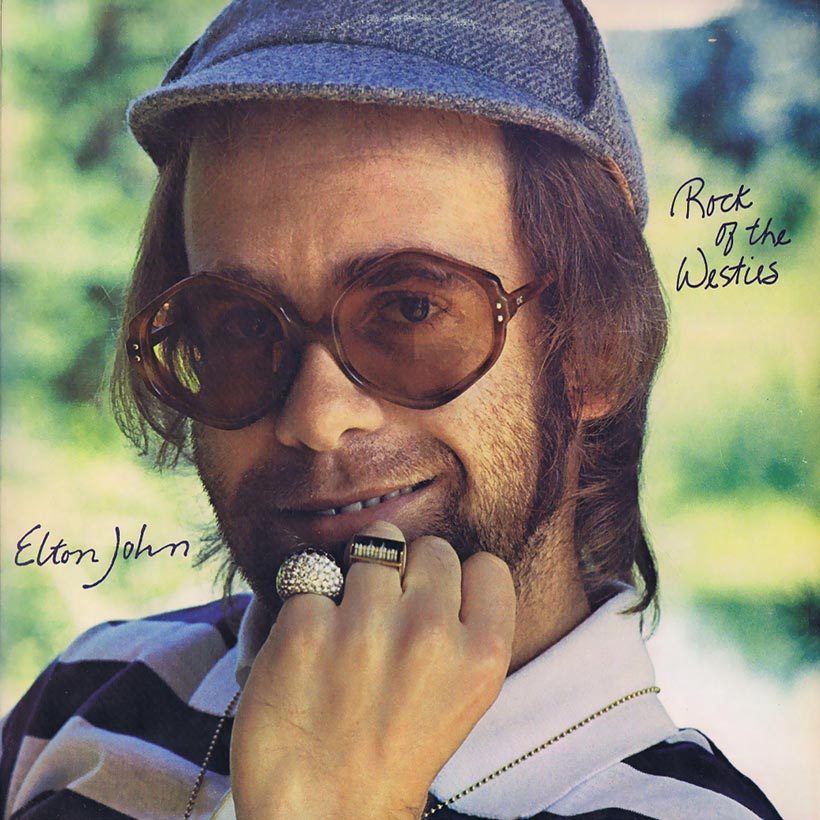‘Rock Of The Westies’: Yet Another Peak In Elton John’s Stunning Career
Continuing Elton John’s unbeatable run in the 70s, the ’Rock Of The Westies’ album found him scaling ever greater heights.

In the era of his undisputed commercial sovereignty, Elton John’s record sales were so spectacular that it’s easy to overlook some of the detail. It’s often noted that he became the first artist ever to debut at No.1 on the Billboard album chart, with Captain Fantastic And The Brown Dirt Cowboy.
Less often repeated is the fact that he did it again with his follow-up, Rock Of The Westies – and, perhaps most remarkably of all, that album was released just five months later, on October 24, 1975.
Why spoil a good pun?
The title was a typical example of Elton’s humor, and a description of an album made “West of the Rockies.” For the third studio album in a row, he and his musical retinue decamped to the Caribou Ranch in Colorado – strictly speaking, south-east of the Rocky Mountains, but why spoil a good pun?
The new challenge was to follow an album that Elton has continued to describe as his best-ever. Rock Of The Westies resumed the song-by-song approach that had preceded the deeply autobiographical Captain Fantastic…, and was made with both familiar accomplices and new studio blood.
Davey Johnstone and Ray Cooper retained their roles in the group, but Dee Murray and Nigel Olsson were replaced on bass and drums, respectively, by the American Kenny Passarelli and Elton’s old friend Roger Pope. It almost goes without saying that all nine new songs were John-Taupin collaborations, and that Gus Dudgeon was in the producer’s chair once again.
A widespread winner
The album was introduced by the bouncy lead single, “Island Girl,” which came out a month earlier. The Caribbean flavour to the lyrics was mirrored by the instrumentation, with Cooper on marimba as well as conga and tambourine. The song was a widespread winner, with Top 20 placings in the UK and Australia, but really rang the bell in the US, where it went to No.1 in just its fourth week on the Hot 100.
Aptly, the record it succeeded was “Bad Blood,” by Neil Sedaka, whose career had been spectacularly revived by his deal with Elton’s Rocket Records, and whose single featured guest vocals by the label boss. Outside of his North American deal with MCA, Rock Of The Westies would be Elton’s last studio album on DJM, before he himself switched to Rocket.
“Island Girl” stayed at the US top spot for three weeks, providing the perfect curtain-raiser for Rock Of The Westies. Cooper, now in his percussive pomp, played a suitably extravagant array of instruments throughout, also including cowbell, jawbone, castanets, bell tree, vibraphone, shaker, wind chimes, maracas, and kettle drums. Johnstone was much in evidence on electric guitar and Kiki Dee sang backing vocals on most of the record.
Growing some funk of his own
Rock Of The Westies opened, boldly, with a medley featuring three separate song elements, “Yell Help,” “Wednesday Night,”and “Ugly.” Frequent accomplice James Newton Howard played Hohner clavinet, ARP synthesiser and harpsichord, and was much featured elsewhere on electric piano and synthesizer. Soul trio Labelle provided backing vocals.
The ensuing “Dan Dare (Pilot Of The Future)” had been Elton’s preference as a single instead of “Island Girl.” It featured detail from Johnstone on “voice bag,” the device that found fame as a vocoder the following year on Peter Frampton’s “Show Me The Way.”
“Island Girl” was followed by the two songs that formed the only other single from the set, which came from opposite ends of John’s repertoire. “Grow Some Funk Of Your Own” (which had an additional writing credit for Johnstone) was an out-and-out rocker with a humorous Taupin lyric about an amorous tourist being told in no uncertain times where to go by a possessive boyfriend. “I Feel Like A Bullet (In The Gun Of Robert Ford)” was a fine ballad that was generally underrated, but helped the double-A-side to a No.14 peak in the US.
The second half of the album featured another extended rocker, “Street Kids,” among a number of lesser-celebrated Elton entries that also included the pensive, midtempo “Hard Luck Story.” That song had previously been recorded by Dee, another Rocket signing. “Feed Me” was a more soulfully-rendered piece, with the lush harmonies that pervaded much of the album, and the closing “Billy Bones And The White Bird” gave it an upbeat finale with a Bo Diddley beat and heavy percussion.
Reaching new heights
Rock Of The Westies debuted at No.1 in America on Billboard’s November 8 chart, succeeding Jefferson Starship’s Red Octopus. Its three-week rule gave Elton a remarkable total of 15 weeks atop the chart, including five with Elton John’s Greatest Hits and seven (in total) for Captain Fantastic And The Brown Dirt Cowboy.
Listen to the best of Elton John on Apple Music and Spotify.
Three days before Rock Of The Westies’ release, he received a star on Hollywood’s Walk Of Fame, as part of Elton John Week. He was now reaching heights previously achieved solely by The Beatles, the only previous music act to play at Dodger Stadium in Los Angeles. Elton’s famous concert there on October 26 had him playing in Dodgers uniform, suitably besequinned. The following March, in London, he became the first rock star since The Beatles to be immortalised in wax at Madame Tussaud’s.
Buy or stream Rock Of The Westies.













Tina Benez
December 2, 2022 at 3:01 am
Thank you for ur astute tribute/review! Love ROTW too! – especially “Bullet” and, “Island Girl.” And LaBelle works so well at the end of the album’s opening medley! I’m wonder what your opinion is on Elton’s next, “Blue Moves,” is… Take care from San Francisco! 🙂 Tina Benez